Can Differing Opinions Hinder Partnerships for the Localization of the Sustainable Development Goals? Evidence from Marginalized Urban Areas in Andalusia
Abstract
1. Introduction
1.1. Global Trends in Urban Growth and Social Segregation: A Challenge to Social Justice
1.2. The Incorporation of the New Urban Agenda into the 2030 Agenda for Sustainable Development
1.3. Addressing Social Exclusion in Urban Areas under the Light of the 2030 Agenda: The Importance of Collaborative Partnerships
1.4. Factors That May Promote or Hinder Collaborative Partnerships: The Role of Differing Perceptions
1.5. Our Case Study: Six Marginalized Urban Neighborhoods in Andalusia (Spain)
2. Materials, Data Collection, and Methods
- To preserve the anonymity of the participants and the possible identification of their answers, the information is presented only in an aggregated way.
- To prevent the identification of their neighborhoods, we note the areas with a code composed of a letter and a number; the number refers to the city, and the letter refers to the neighborhood. In this study, three of the six neighborhoods studied are noted as 1A, 1B, and 1C, as they are located in the same city, with a population of approximately 8000, 12,000, and 3000, respectively. The remaining neighborhoods are noted as 2A, 3A, and 4A to reflect that they belong to the other three cities. These last neighborhoods (2A, 3A, and 4A) have approximately 45,000, 10,000, and 32,000 residents, respectively.
3. Results and Discussion
3.1. The Identification of a Multidimensional Problem: A Descriptive Analysis
- V0303: The quality of education received by children in the neighborhood is relatively similar to that of the rest of the city.
- V0311: The presence of illegal activities related to prostitution is not one of the main problems of the neighborhood.
- V0320: Either there are no adequate health centers in the neighborhood, or the existing centers are very low quality.
- V0324: The neighborhood is well connected with the rest of the city.
- V0326: The distribution of the buildings in the neighborhood greatly facilitates the coexistence between neighbors.
- V0301: The educational level reached in the neighborhood by its residents is much lower than the rest of the city.
- V0310: One of the main problems of the neighborhood is the presence of illegal activities related to drugs.
- V0318: People have an image of the neighborhood as a dangerous place to be avoided.
- V0321: There are too many people in the neighborhood who suffer psychological problems (depression, anxiety, stress, etc.).
- V0328: One of the main problems of the neighborhood is housing (illegal sale, occupation, etc.).
3.2. The Recognition of Differing Opinions among the Participants in the Partnerships: Bivariant Analyses
3.2.1. Sociodemographic Characteristics
3.2.2. Characteristics of the Organizations
4. Conclusions
Author Contributions
Funding
Conflicts of Interest
Appendix A
| Topics Included in the Survey. Rated from 0 (i.e., Totally Disagree) to 5 (i.e., Totally Agree). |
|---|
| V0301. The educational level reached in the neighborhood by its residents is much lower than the rest of the city. |
| V0302. The quality of the educational facilities in the neighborhood is much lower than in the rest of the city |
| V0303. The quality of education received by children in the neighborhood is relatively similar to that of the rest of the city. |
| V0304. In general, families are very committed to the education of their children. |
| V0305. The low educational level of the residents of the neighborhood is what most hinders their access to employment. |
| V0306. When my neighbors look for a job, they are discriminated against by the neighborhood they come from. |
| V0307. In the neighborhood there are a sufficient number of socio-labor integration programs. |
| V0308. The socio-labor integration programs that exist are very useful for the residents. |
| V0309. Regardless of their work situation or where they get their income, families in the neighborhood generally do not have great difficulty making ends meet. |
| V0310. One of the main problems of the neighborhood is the presence of illegal activities related to drugs. |
| V0311. The presence of illegal activities related to prostitution is not one of the main problems of the neighborhood. |
| V0312. I would say that my neighborhood is a much more insecure place than the rest of the city, especially for its neighbors. |
| V0313. I would say that my neighborhood is a much more insecure place than the rest of the city, but only for people from outside. |
| V0314. In my neighborhood there is a lot of cultural and ethnic diversity, especially due to the presence of immigrants. |
| V0315. In my neighborhood there is a lot of cultural and ethnic diversity, especially due to the presence of payos and Roma people. |
| V0316. The coexistence between neighbors is calm and cordial, it is very rare that conflicts occur in the neighborhood. |
| V0317. When conflicts do occur, they are usually serious, with possible injuries or deaths. |
| V0318. People have an image of the neighborhood as a dangerous place that is better to avoid. |
| V0319. In general, there are no serious health problems in the neighborhood, most people are healthy as anywhere. |
| V0320. Either there are no adequate health centers in the neighborhood, or the existing centers are very low quality. |
| V0321. There are too many people in the neighborhood who suffer psychological problems (depression, anxiety, stress, etc.). |
| V0322. In general, the situation of families is calm, there are not many conflicts, neither with a partner nor with parents and children. |
| V0323. The residents of the neighborhood, in general, feel comfortable leaving the neighborhood and making life outside it. |
| V0324. The neighborhood is well connected with the rest of the city. |
| V0325. It is common to see people from outside doing normal life in the neighborhood. |
| V0326. The distribution of the buildings in the neighborhood greatly facilitates the coexistence between neighbors. |
| V0327. In the neighborhood there are enough green areas and open spaces to be together with family and friends. |
| V0328. One of the main problems of the neighborhood is housing (illegal sale, occupation, etc.). |
| V0329. The administrations (City Council, Andalusian Government, and Central Government) are very concerned about the neighborhood and do their best to solve the problems we have. |
| V0330. The actions of the administrations in the neighborhood have managed to improve it. |
| V0331. Administrations do everything to avoid illegal behaviors in the neighborhood. |
| V0332. Administrations support and trust neighborhood entities to solve problems together. |
| V0333. The residents of the neighborhood tend to trust each other, there is a climate of trust. |
| V0334. I think that, in general, my neighbors are very proud to belong to the neighborhood. |
| V0335. I think that, if they could, an overwhelming majority of neighbors would leave the neighborhood to go to another. |
| V0336. I think that, in general, the people of the neighborhood are committed to transforming it into a more pleasant environment to live in. |
References
- Graute, U. Local Authorities Acting Globally for Sustainable Development. Reg. Stud. 2016, 50, 1931–1942. [Google Scholar] [CrossRef]
- Council of Europe. Sustainable Urban Development Fostering Social Inclusion; Resolution 2285; Council of Europe: Brussels, Belgium, 2019. [Google Scholar]
- Klopp, J.M.; Petretta, D.L. The urban sustainable development goal: Indicators, complexity and the politics of measuring cities. Cities 2017, 63, 92–97. [Google Scholar] [CrossRef]
- Economic and Social Council. Report of the Inter-Agency and Expert Group on Sustainable Development Goal Indicators; Economic and Social Council: New York, NY, USA, 2016; Volume E/CN.3/2016/2/Rev.1. [Google Scholar]
- Fischer, A.M. Poverty as Ideology: Rescuing Social Justice from Global Development Agendas; Zed Books: London, UK, 2018; ISBN 978-1-78699-045-7. [Google Scholar]
- Cohen, M.A. From Habitat II to Pachamama: A growing agenda and diminishing expectations for Habitat III. Environ. Urban. 2016, 28, 35–48. [Google Scholar] [CrossRef]
- United Nations. Transforming Our World: The 2030 Agenda for Sustainable Development; United Nations: New York, NY, USA, 2015. [Google Scholar]
- Barnett, C.; Parnell, S. Ideas, implementation and indicators: Epistemologies of the post-2015 urban agenda. Environ. Urban. 2016, 28, 87–98. [Google Scholar] [CrossRef]
- Lucci, P. An Urban Dimension in A New Set of Development Goals; ODI Working Paper: London, UK, 2014. [Google Scholar]
- Rogers, R. Cities for a small planet. World Herit. Rev. 1996, 68–77. [Google Scholar]
- Rudd, A.; Simon, D.; Cardama, M.; Birch, E.L.; Revi, A. The UN, the Urban Sustainable Development Goal, and the New Urban Agenda. Urban Planet 2018, 2002, 180–196. [Google Scholar] [CrossRef]
- Kaika, M. ‘Don’t call me resilient again!’: The New Urban Agenda as immunology … or … what happens when communities refuse to be vaccinated with ‘smart cities’ and indicators. Environ. Urban. 2017, 29, 89–102. [Google Scholar] [CrossRef]
- Sjöstedt, M. Aid effectiveness and the Paris Declaration: A mismatch between ownership and results-based management? Public Adm. Dev. 2013, 10, 143–155. [Google Scholar] [CrossRef]
- Faust, J.; Messner, D. Organizational Challenges for an Effective Aid Architecture—Traditional Deficits, the Paris Agenda and Beyond; Deutsches Institut für Entwicklungspolitik: Bonn, Germany, 2007; ISBN 978-3-88985-360-8. [Google Scholar]
- Kazepov, Y.; Barberis, E. The territorial dimension of social policies and the new role of cities. In Handbook of European Social Policy; Kennett, P., Lendvai-Bainton, N., Eds.; Edward Elgar Publishing: London, UK, 2017; pp. 302–318. ISBN 978-1-78347-645-9. [Google Scholar]
- Crawford, M. Abandoning Silos. How Innovative Governments Are Collaborating Horizontally To Solve Complex Problems; Mowat Centre: Toronto, TO, Canada, 2018; Volume 178, ISBN 9781772590739. [Google Scholar]
- Moreno-Serna, J.; Sánchez-Chaparro, T.; Mazorra, J.; Arzamendi, A.; Stott, L.; Mataix, C. Transformational collaboration for the SDGs: The alianza shire’s work to provide energy access in refugee camps and host communities. Sustainability 2020, 12. [Google Scholar] [CrossRef]
- McQuaid, R.W. The theory of partnership: Why have partnerships? In public-private partnerships. Routledge Adv. Manag. Bus. Stud. 2000, 19, 9–35. [Google Scholar]
- Dugarova, E. Social Inclusion, Poverty Eradication and the 2030 Agenda for Sustainable Development; UNRISD Working Paper; UNRISD: Geneva, Switzerland, 2015. [Google Scholar]
- Bellali, J.; Dellas, E.; Fischer, K.; Strauch, L. Sustainable Development Goals, New Urban Agenda and the Urban Nexus; Adelphi: Berlin, Germany, 2016. [Google Scholar]
- Le Blanc, D. Towards Integration at Last? The Sustainable Development Goals as a Network of Targets. Sustain. Dev. 2015, 23, 176–187. [Google Scholar] [CrossRef]
- Helgason, K.S. The 2030 Agenda for Sustainable Development: Recharging Multilateral Cooperation for the Post-2015 Era. Glob. Policy 2016, 7, 431–440. [Google Scholar] [CrossRef]
- Horan, D. A new approach to partnerships for SDG transformations. Sustainability 2019, 11, 1–22. [Google Scholar] [CrossRef]
- Westman, L.; Broto, V.C. Climate governance through partnerships: A study of 150 urban initiatives in China. Glob. Environ. Chang. 2018, 50, 212–221. [Google Scholar] [CrossRef]
- Ma, L.; Li, J.; Jin, R.; Ke, Y.; Yuan, J. A holistic review of public-private partnership literature published between 2008 and 2018. Adv. Civ. Eng. 2019, 2019. [Google Scholar] [CrossRef]
- Hodge, G.A.; Greve, C. Public—Private Partnerships: An International Performance Review. Public Adm. Rev. 2007, 67, 545–558. [Google Scholar] [CrossRef]
- Wang, H.; Xiong, W.; Wu, G.; Zhu, D. Public–private partnership in Public Administration discipline: A literature review. Public Manag. Rev. 2018, 20, 293–316. [Google Scholar] [CrossRef]
- Torchia, M.; Calabrò, A.; Morner, M. Public–Private Partnerships in the Health Care Sector: A systematic review of the literature. Public Manag. Rev. 2015, 17, 236–261. [Google Scholar] [CrossRef]
- Reeves, E. A Review of the PPP Experience in Ireland: Lessons for Comparative Policy Analysis. J. Comp. Policy Anal. Res. Pract. 2015, 17, 467–480. [Google Scholar] [CrossRef]
- McQuaid, R.W. The Role of Partnerships in Regional and Urban development at The Turn of the Century. In Europe Quo Vadis? Regional Questions at the Turn of the Century, Proceedings of the 38th Congress of the European Regional Science Association, Vienna, Austria, 28 August–1 September 1998; European Regional Science Association: Louvain-la-Neuve, Belgium, 1998. [Google Scholar]
- Jiang, Y.; Ritchie, B.W. Disaster collaboration in tourism: Motives, impediments and success factors. J. Hosp. Tour. Manag. 2017, 31, 70–82. [Google Scholar] [CrossRef]
- McNeish, R.; Rigg, K.K.; Tran, Q.; Hodges, S. Community-based behavioral health interventions: Developing strong community partnerships. Eval. Program Plan. 2019, 73, 111–115. [Google Scholar] [CrossRef] [PubMed]
- Renn, O. Stakeholder and Public Involvement in Risk Governance. Int. J. Disaster Risk Sci. 2015, 6, 8–20. [Google Scholar] [CrossRef]
- Danley, S.; Christiansen, G. Conflicting Responsibilities: The Multi-Dimensional Ethics of University/Community Partnerships. J. Community Engagem. Scholarsh. 2019, 11, 3. [Google Scholar]
- Ward, M.; Schulz, A.J.; Israel, B.A.; Rice, K.; Martenies, S.E.; Markarian, E. A conceptual framework for evaluating health equity promotion within community-based participatory research partnerships. Eval. Prog. Plan. 2018, 70, 25–34. [Google Scholar] [CrossRef]
- Edwards, P.; Sharma-Wallace, L.; Barnard, T.; Velarde, S.J.; Warmenhoven, T.; Fitzgerald, G.; Harrison, D.; Garrett, L.; Porou, T.; Pohatu, P. Sustainable livelihoods approaches to inform government-local partnerships and decision-making in vulnerable environments. N. Z. Geog. 2019, 75, 63–73. [Google Scholar] [CrossRef]
- Lewis, S.; Bambra, C.; Barnes, A.; Collins, M.; Egan, M.; Halliday, E.; Orton, L.; Ponsford, R.; Powell, K.; Salway, S.; et al. Reframing “participation” and “inclusion” in public health policy and practice to address health inequalities: Evidence from a major resident-led neighbourhood improvement initiative. Health. Soc. Care Community 2019, 27, 199–206. [Google Scholar] [CrossRef]
- Ansell, C.; Gash, A. Collaborative governance in theory and practice. J. Public Adm. Res. Theory 2008, 18, 543–571. [Google Scholar] [CrossRef]
- Stott, L. Shaping Sustainable Change: The Role of Partnership Brokering in Optimising Collaborative Action; Publishing, G., Ed.; Routledge: London, UK, 2018; ISBN 978-1-78353-736-5. [Google Scholar]
- Soini, K.; Jurgilevich, A.; Pietikäinen, J.; Korhonen-Kurki, K. Universities responding to the call for sustainability: A typology of sustainability centres. J. Clean. Prod. 2018, 170, 1423–1432. [Google Scholar] [CrossRef]
- Simmons, V.N.; Klasko, L.B.; Fleming, K.; Koskan, A.M.; Jackson, N.T.; Noel-Thomas, S.; Luque, J.S.; Vadaparampil, S.T.; Lee, J.H.; Quinn, G.P.; et al. Participatory evaluation of a community-academic partnership to inform capacity-building and sustainability. Eval. Prog. Plan. 2015, 52, 19–26. [Google Scholar] [CrossRef]
- Xiong, W.; Chen, B.; Wang, H.; Zhu, D. Governing public–private partnerships: A systematic review of case study literature. Aust. J. Public Adm. 2019, 78, 95–112. [Google Scholar] [CrossRef]
- Okeyo, I.; Lehmann, U.; Schneider, H. The impact of differing frames on early stages of intersectoral collaboration: The case of the First 1000 Days Initiative in the Western Cape Province. Health Res. Policy Syst. 2020, 18, 1–14. [Google Scholar] [CrossRef] [PubMed]
- Seitanidi, M.M.; Ryan, A. A critical review of forms of corporate community involvement: From philanthropy to partnerships. Int. J. Nonprofit Volunt. Sect. Mark. 2007, 12, 247–266. [Google Scholar] [CrossRef]
- McQuaid, R.W. Theory of organizational partnerships: Partnership advantages, disadvantages and success factors. In The New Public Governance? Emerging Perspectives on the Theory and Practice of Public Governance; Osborne, S.P., Ed.; Routledge: London, UK, 2009; pp. 127–148. ISBN 020386168X. [Google Scholar]
- Egfjord, K.F.H.; Sund, K.J. Do you see what I see? How differing perceptions of the environment can hinder radical business model innovation. Technol. Forecast. Soc. Chang. 2020, 150, 119787. [Google Scholar] [CrossRef]
- Klitsie, E.J.; Ansari, S.; Volberda, H.W. Maintenance of Cross-Sector Partnerships: The Role of Frames in Sustained Collaboration. J. Bus. Ethics 2018, 150, 401–423. [Google Scholar] [CrossRef] [PubMed]
- Leiser, D.; Benita, R.; Bourgeois-Gironde, S. Differing conceptions of the causes of the economic crisis: Effects of culture, economic training, and personal impact. J. Econ. Psychol. 2016, 53, 154–163. [Google Scholar] [CrossRef]
- Gangl, K.; Kastlunger, B.; Kirchler, E.; Voracek, M. Confidence in the economy in times of crisis: Social representations of experts and laypeople. J. Socio Econ. 2012, 41, 603–614. [Google Scholar] [CrossRef]
- Sanyé-Mengual, E.; Anguelovski, I.; Oliver-Solà, J.; Montero, J.I.; Rieradevall, J. Resolving differing stakeholder perceptions of urban rooftop farming in Mediterranean cities: Promoting food production as a driver for innovative forms of urban agriculture. Agric. Hum. Values 2016, 33, 101–120. [Google Scholar] [CrossRef]
- Austin, J.E.; Seitanidi, M.M. Collaborative Value Creation: A Review of Partnering Between Nonprofits and Businesses. Part 2: Partnership Processes and Outcomes. Nonprofit Volunt. Sect. Q. 2012, 41, 929–968. [Google Scholar] [CrossRef]
- Division for Sustainable Development Goals. Partnership Exchange: Advancing the Global Partnerships for Sustainable Development 2018 Report; Division for Sustainable Development Goals: NY, USA, USA, 2018. [Google Scholar]
- Chyung, S.Y.Y.; Roberts, K.; Swanson, I.; Hankinson, A. Evidence-Based Survey Design: The Use of a Midpoint on the Likert Scale. Perform. Improv. 2017, 56, 15–23. [Google Scholar] [CrossRef]
- Tan, P.J.B. An empirical study of how the learning attitudes of college students toward English E-Tutoring websites affect site sustainability. Sustainability 2019, 11. [Google Scholar] [CrossRef]
- Fan, R.-J.D.; Tan, P.J.B. Application of Information Technology in Preschool Aesthetic Teaching from the Perspective of Sustainable Management. Sustainability 2019, 11, 2179. [Google Scholar] [CrossRef]
- Poortinga, W.; Whitmarsh, L.; Steg, L.; Böhm, G.; Fisher, S. Climate change perceptions and their individual-level determinants: A cross-European analysis. Glob. Environ. Chang. 2019, 55, 25–35. [Google Scholar] [CrossRef]
- Kapusuz, A.G.; Çavuş, M.F.; Pekkan, N.Ü. Perceived Social Support and Social Entrepreneurship: Gender Perspective from Turkey. In Knowledge, Learning and Innovation; Ratten, V., Ed.; Springer: London, UK, 2018; pp. 75–90. ISBN 978-3-319-59281-7. [Google Scholar]
- Oh, H.; Sutherland, M.; Stack, N.; del Mar Badia Martín, M.; Blumen, S.; Nguyen, Q.A.T.; Wormald, C.; Maakrun, J.; Ziegler, A. Adolescents’ social perceptions of academically high-performing students: A country and gender comparative study. Comp. A J. Comp. Int. Educ. 2019, 1–18. [Google Scholar] [CrossRef]
- Cosma, S.A.; Bota, M.; Fleşeriu, C.; Morgovan, C.; Văleanu, M.; Cosma, D. Measuring patients’ perception and satisfaction with the Romanian healthcare system. Sustainability 2020, 12, 1–16. [Google Scholar] [CrossRef]
- Hannan, J.; Sanchez, G.; Musser, E.D.; Ward-Petersen, M.; Azutillo, E.; Goldin, D.; Lara, E.G.; Luna, A.M.; Galynker, I.; Foster, A. Role of empathy in the perception of medical errors in patient encounters: A preliminary study. BMC Res. Notes 2019, 12, 1–5. [Google Scholar] [CrossRef]
- Ma, Y.; Siu, K.W.M.; Zou, G. Contradictory and consistent views on designing an inclusive community-based centre for older people: A mixed-methods study of different age groups in China. Ageing Soc. 2019, 1–20. [Google Scholar] [CrossRef]
- Makita, M.; Woolrych, R.; Sixsmith, J.; Murray, M.; Menezes, D.; Fisher, J.; Lawthom, R. Place (in)securities: Older adults’ perceptions across urban environments in the United Kingdom. Psyecology 2020, 11, 214–231. [Google Scholar] [CrossRef]
- Scharf, T.; Phillipson, C.; Smith, A. Older peoples perceptions of the neighbourhood: Evidence from socially deprived urban areas. Sociol. Res. Online 2003, 8, 1–14. [Google Scholar] [CrossRef]
- Pavlidis, A.; Baker, S. Who participates? Differing perceptions of risk by young people and the impact on strategies for youth participation. Youth Stud. Aust. 2010, 29, 27–34. [Google Scholar]
- Chen, L.; Ye, M.; Wu, Y. Shaping Identity: Older Adults’ Perceived Community Volunteering Experiences in Shanghai. Nonprofit Volunt. Sect. Q. 2020, 1–17. [Google Scholar] [CrossRef]
- Buffel, T.; Phillipson, C.; Scharf, T. Experiences of neighbourhood exclusion and inclusion among older people living in deprived inner-city areas in Belgium and England. Ageing Soc. 2013, 33, 89–109. [Google Scholar] [CrossRef]
- Lee, T.H.; Jan, F.H. Can community-based tourism contribute to sustainable development? Evidence from residents’ perceptions of the sustainability. Tour. Manag. 2019, 70, 368–380. [Google Scholar] [CrossRef]
- Rasoolimanesh, S.M.; Taheri, B.; Gannon, M.; Vafaei-Zadeh, A.; Hanifah, H. Does living in the vicinity of heritage tourism sites influence residents’ perceptions and attitudes? J. Sustain. Tour. 2019, 27, 1295–1317. [Google Scholar] [CrossRef]
- Stokes, J.E. Trajectories of perceived neighborhood quality across the life course: Sociodemographic determinants and implications for well-being. Soc. Sci. Res. 2019, 79, 181–193. [Google Scholar] [CrossRef]
- Sianes, A. Shaping the future of mid-range Northern NGDOS: Ten challenges, ten proposals. Third World Q. 2013, 34, 1458–1474. [Google Scholar] [CrossRef]
- Panda, D.K. Trust, social capital, and intermediation roles in microfinance and microenterprise development. Voluntas 2016, 27, 1242–1265. [Google Scholar] [CrossRef]
- Guerreiro, S.; Botetzagias, I. Empowering communities–the role of intermediary organisations in community renewable energy projects in Indonesia. Local Environ. 2018, 23, 158–177. [Google Scholar] [CrossRef]
- Lewis, D. Organising and Representing the Poor in a Clientelistic Democracy: The Decline of Radical NGOs in Bangladesh. J. Dev. Stud. 2017, 53, 1545–1567. [Google Scholar] [CrossRef]
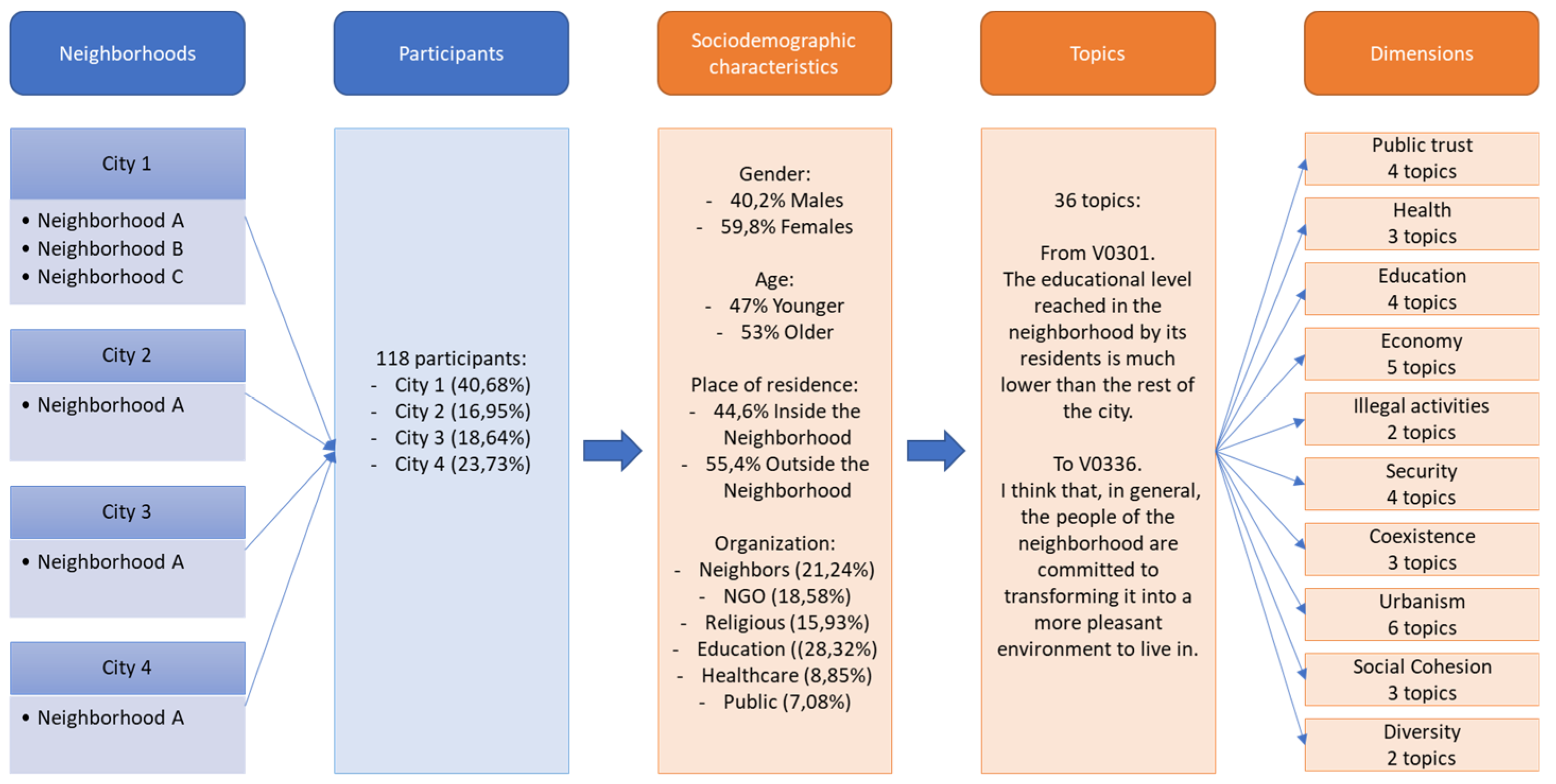
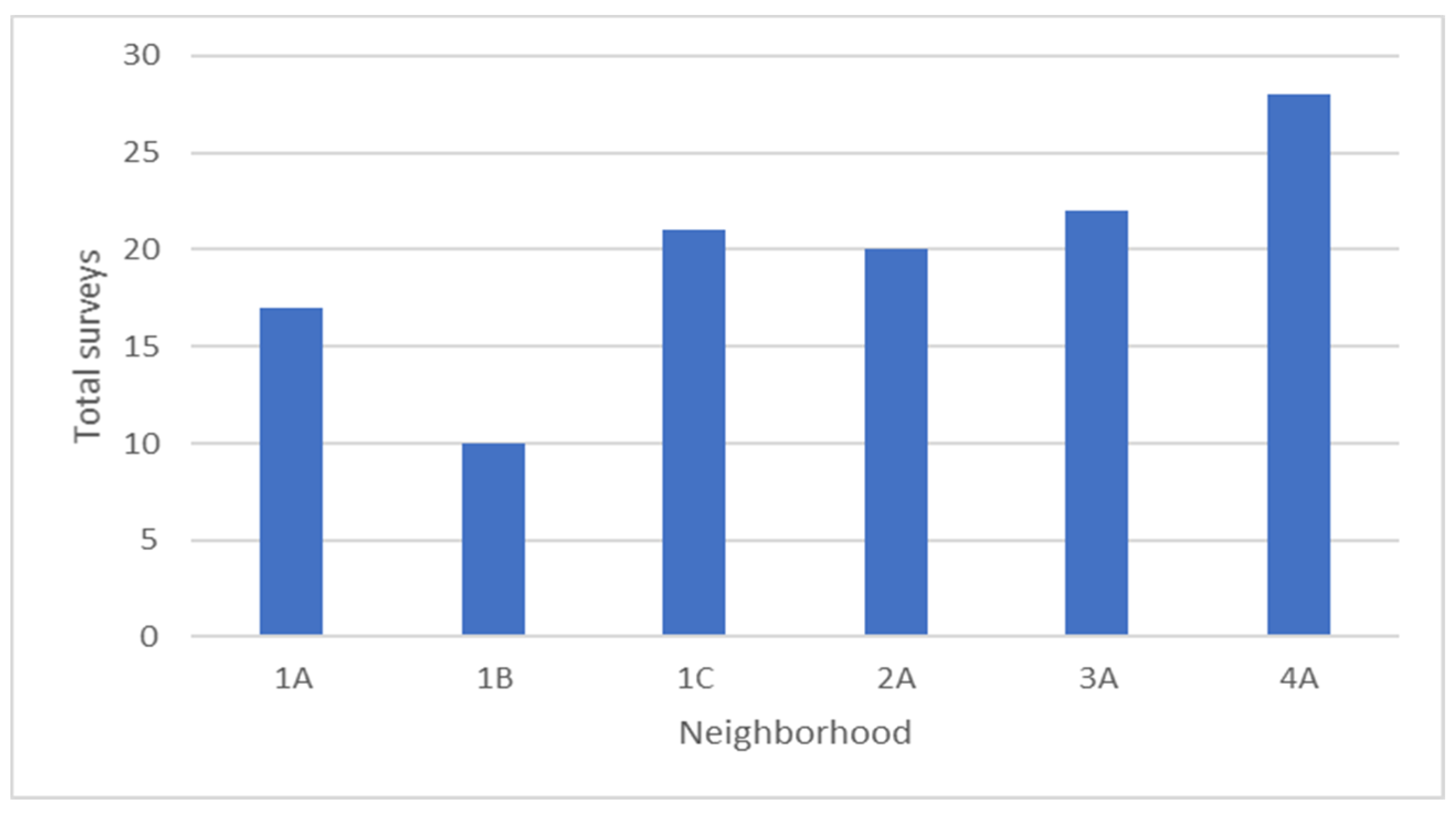
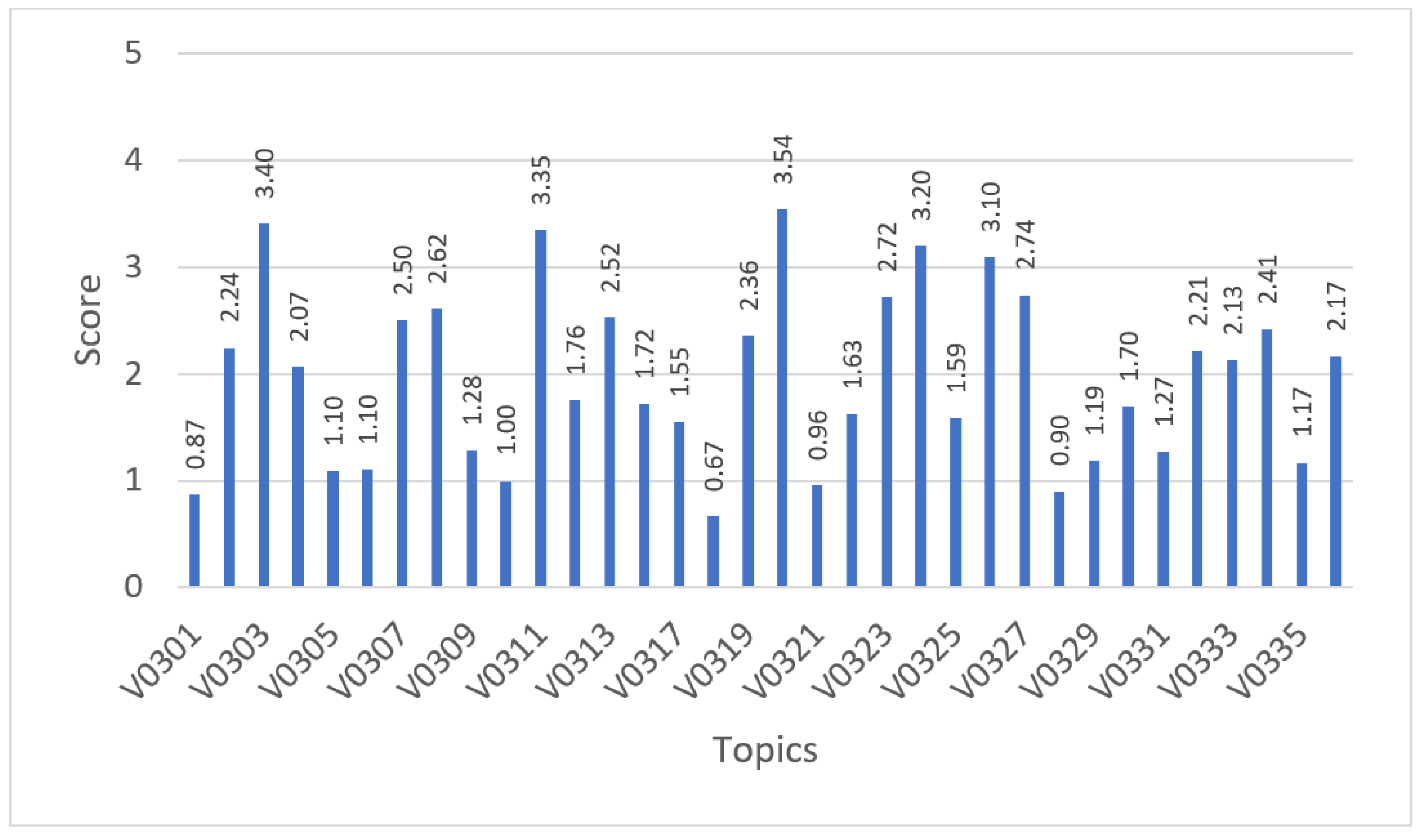
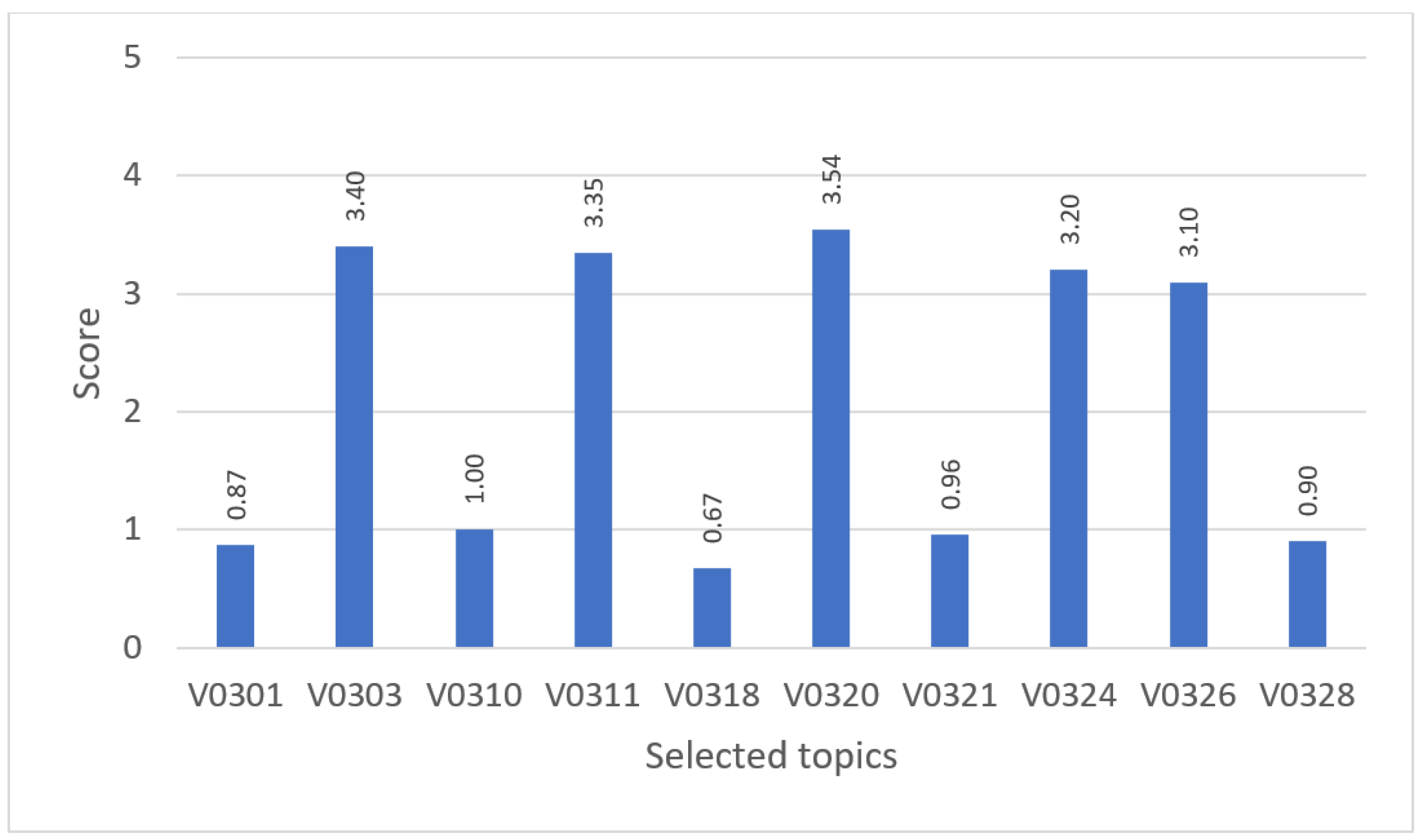
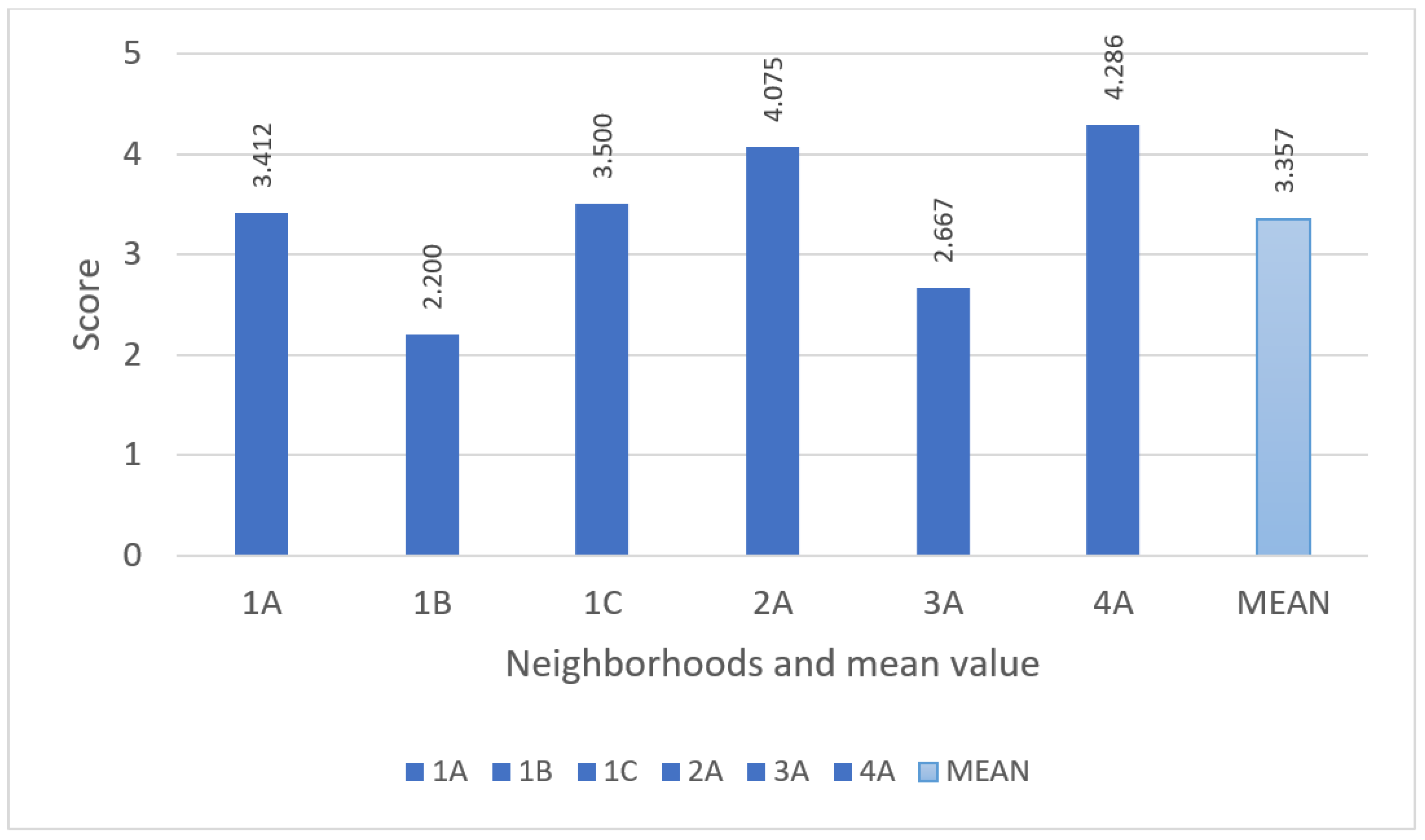
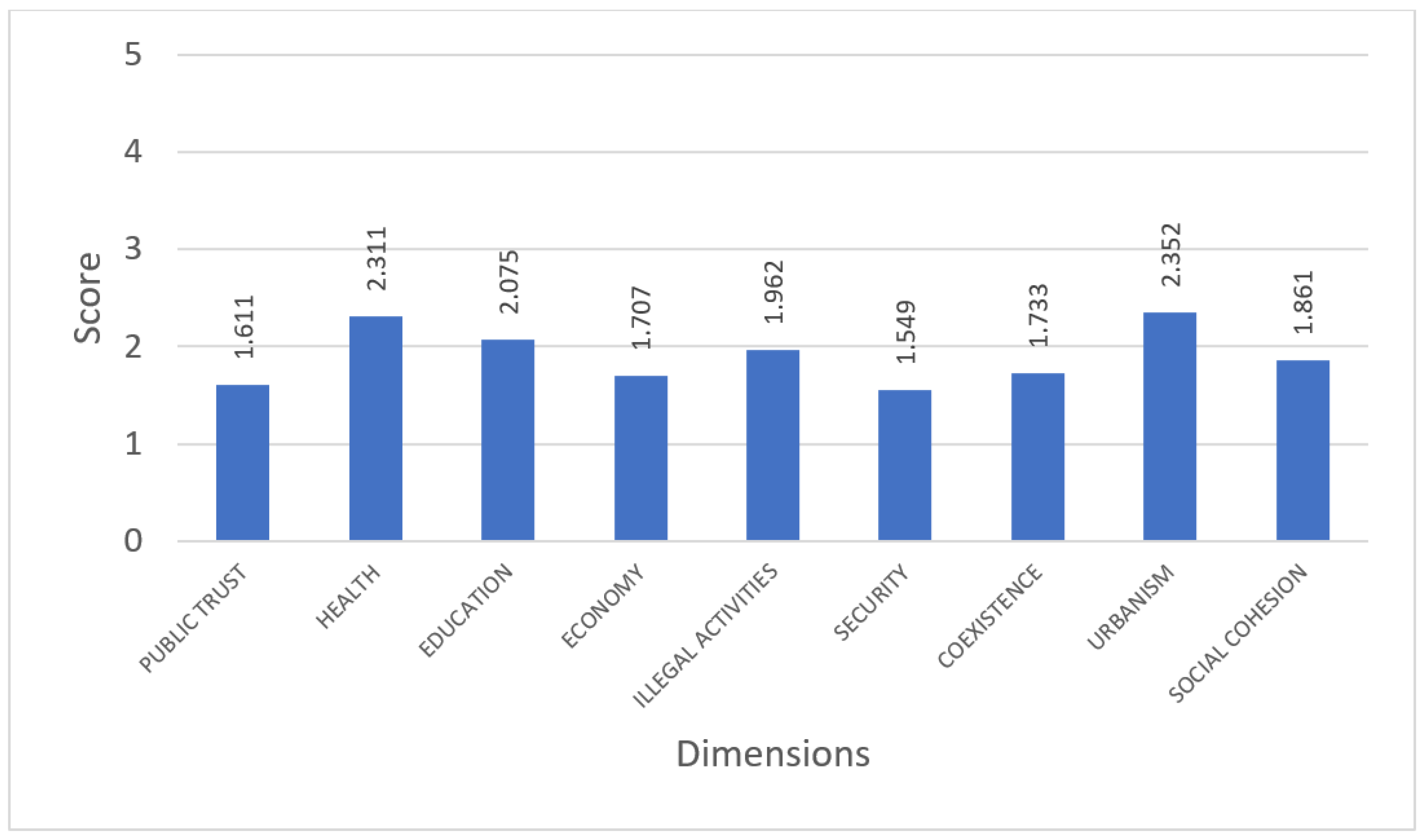

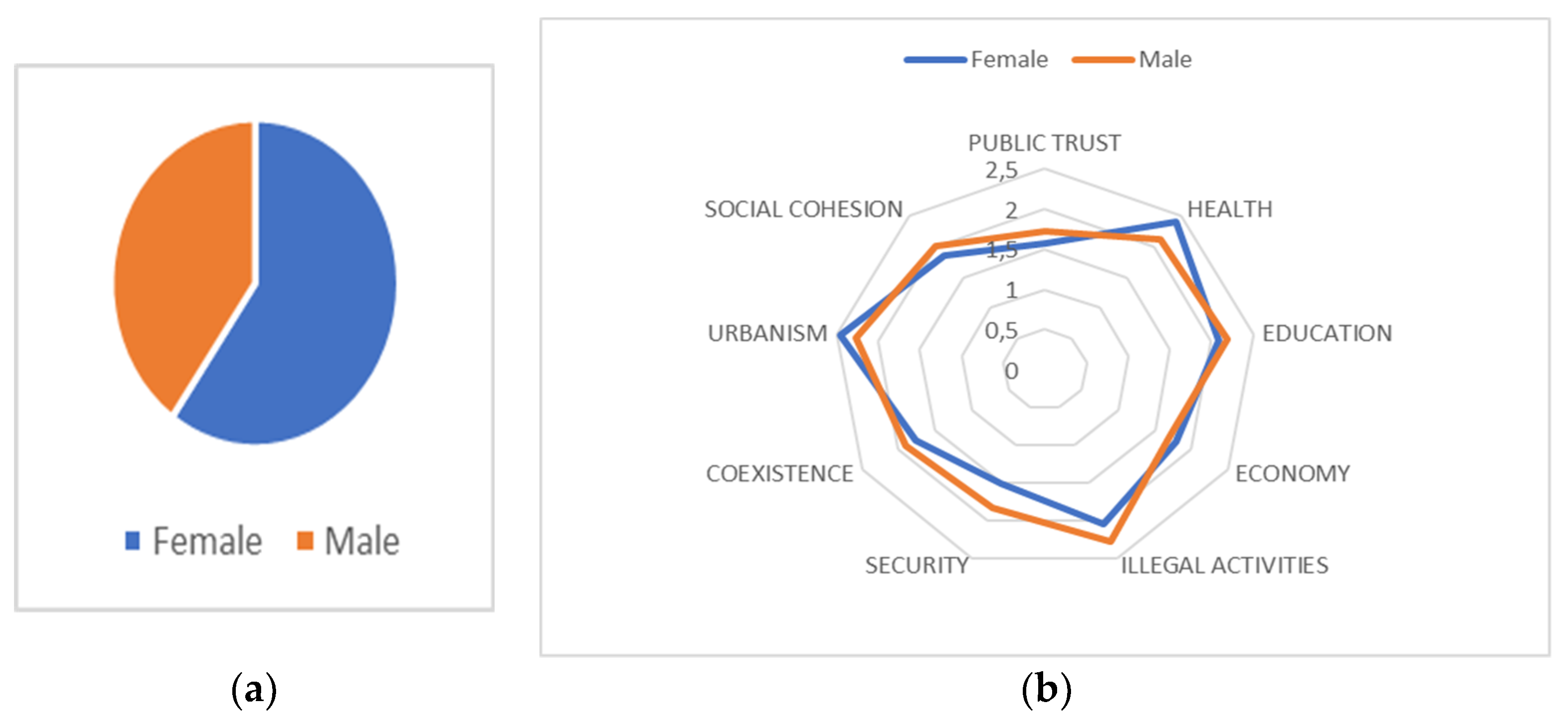
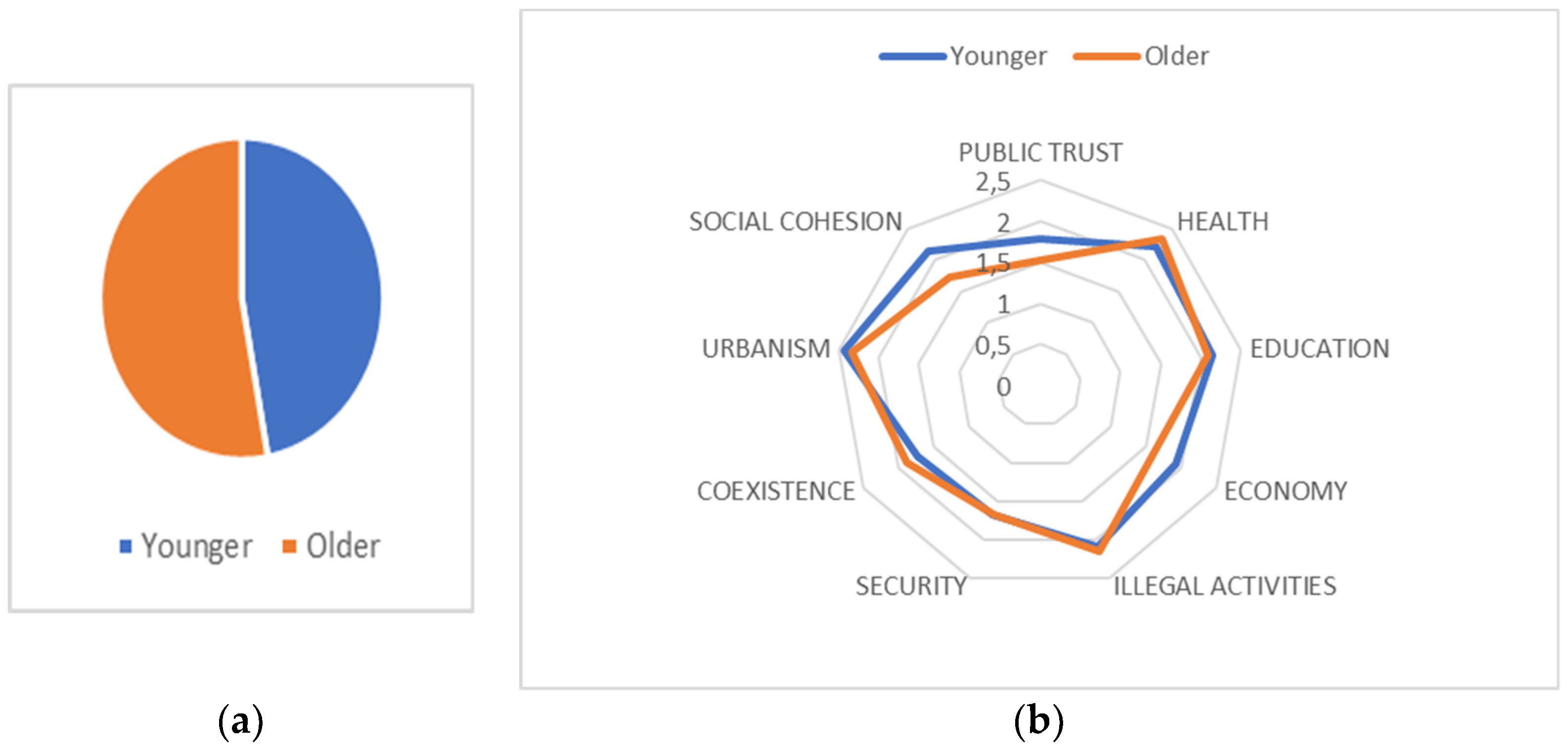
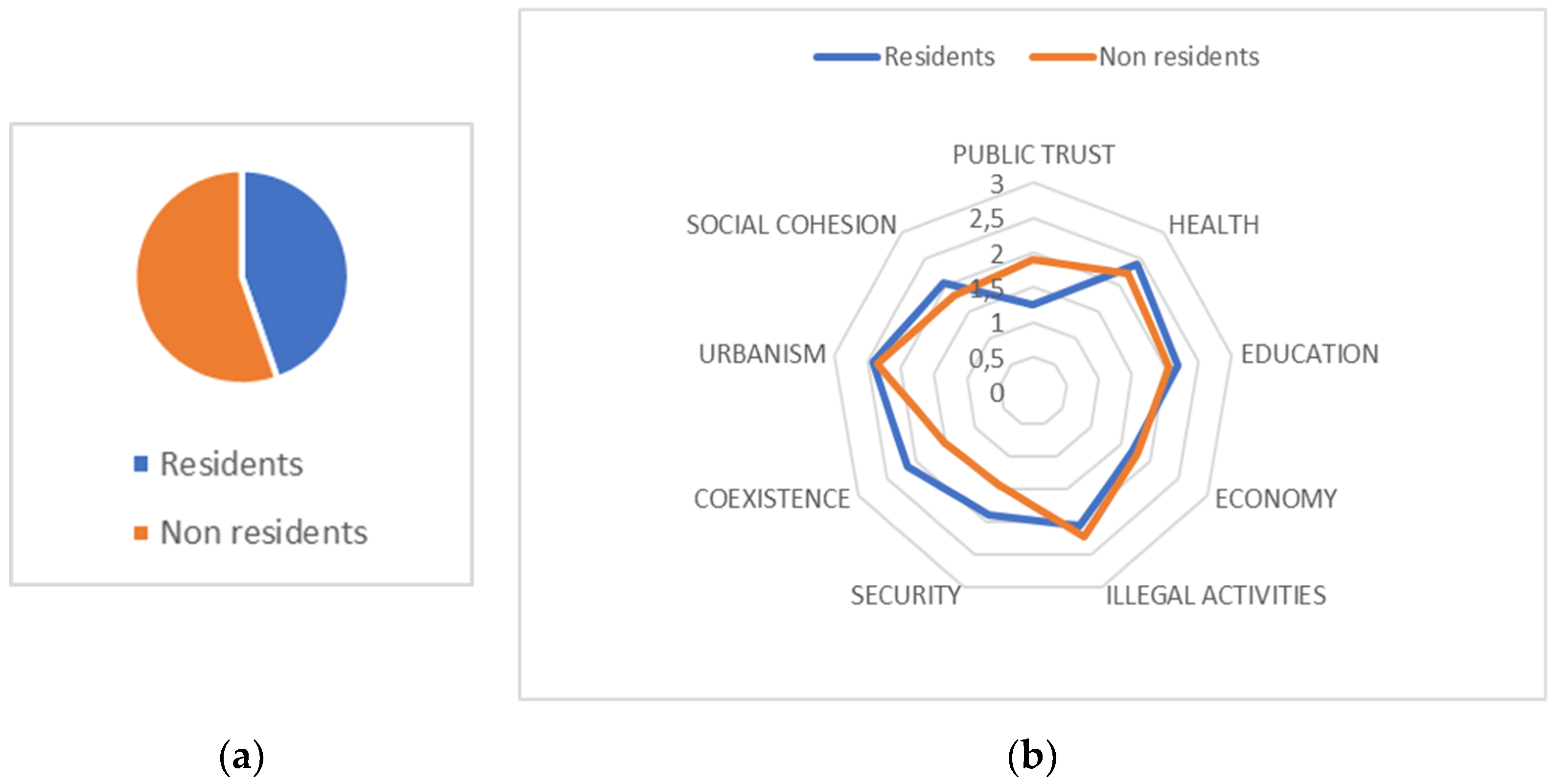
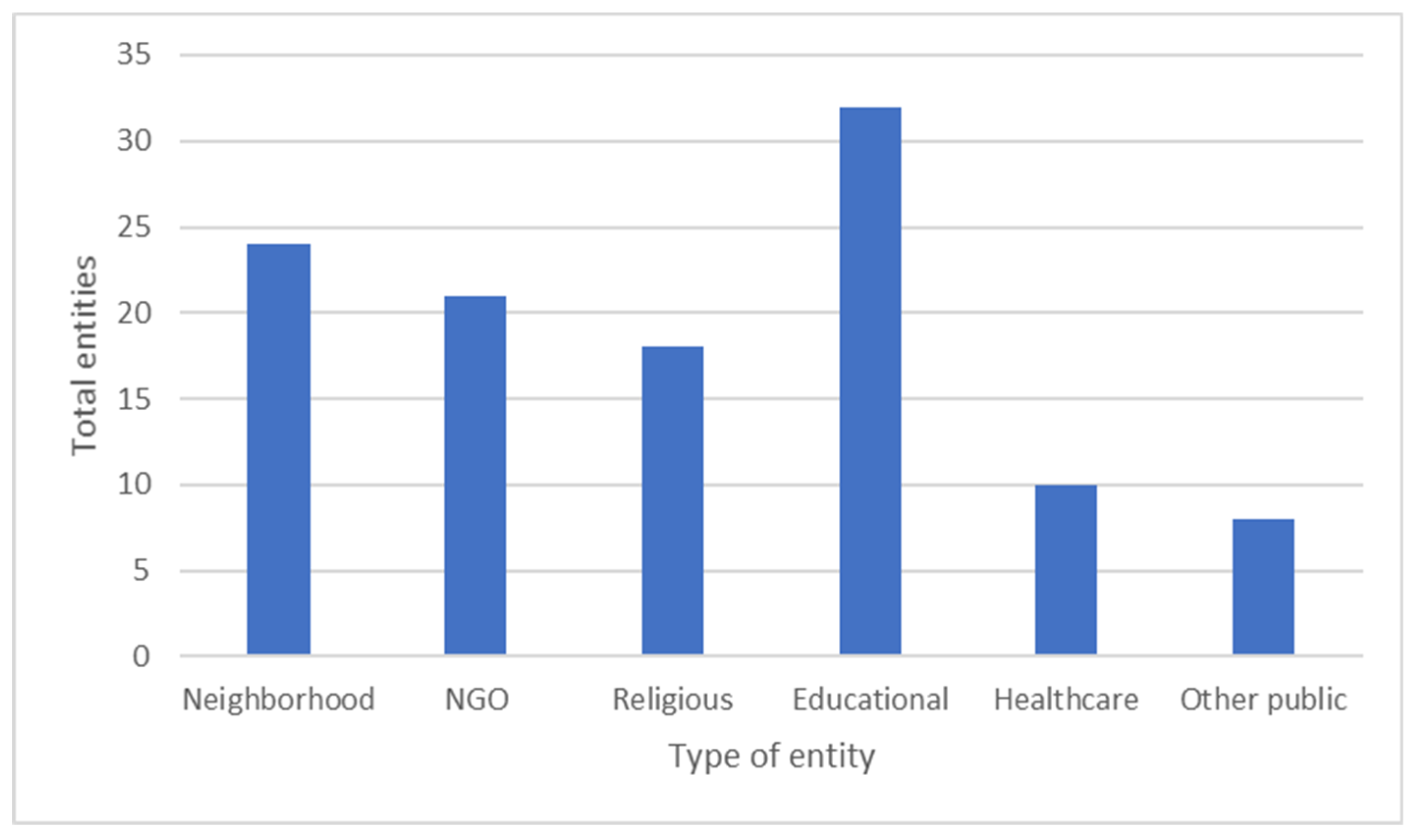
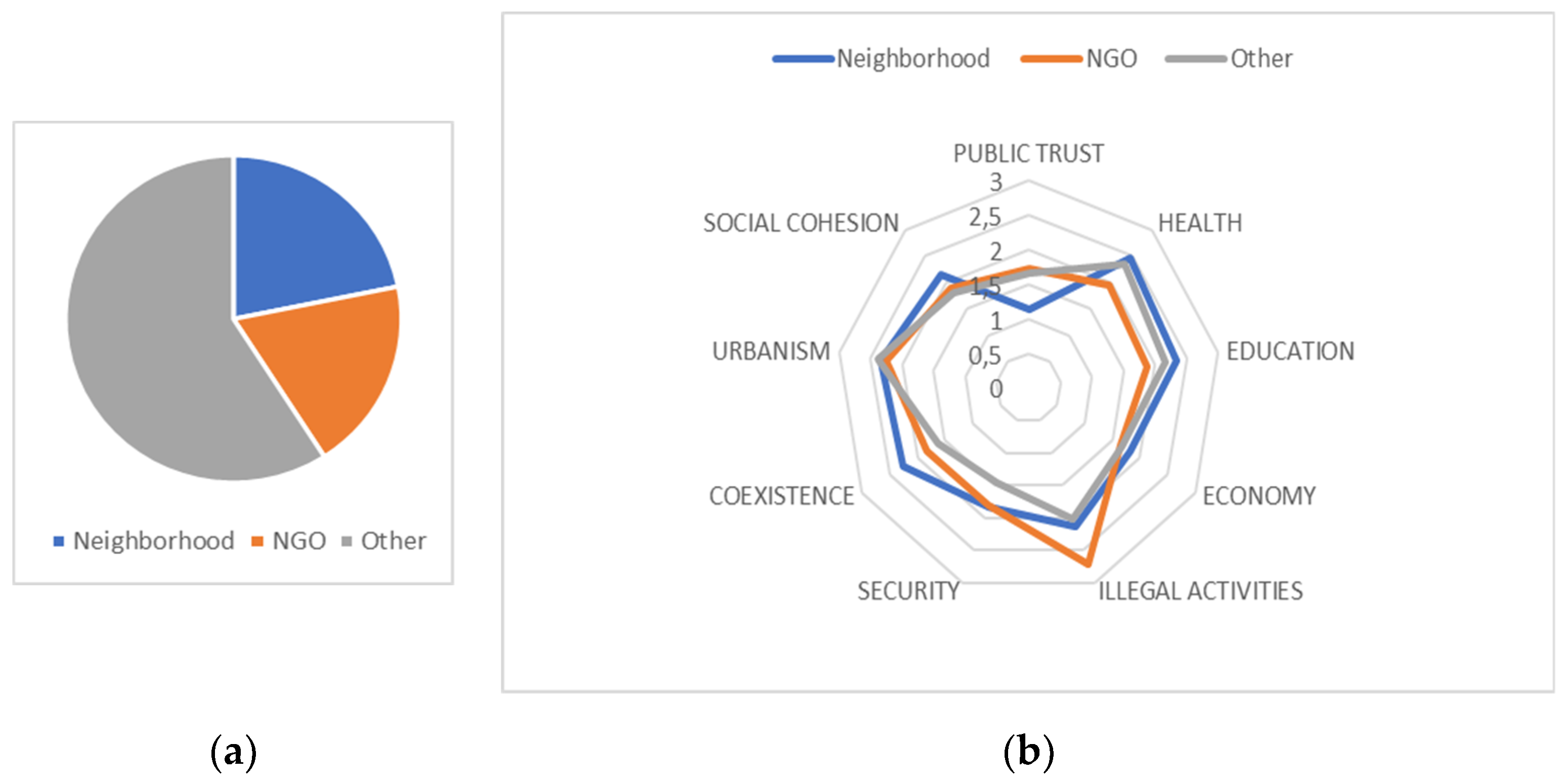
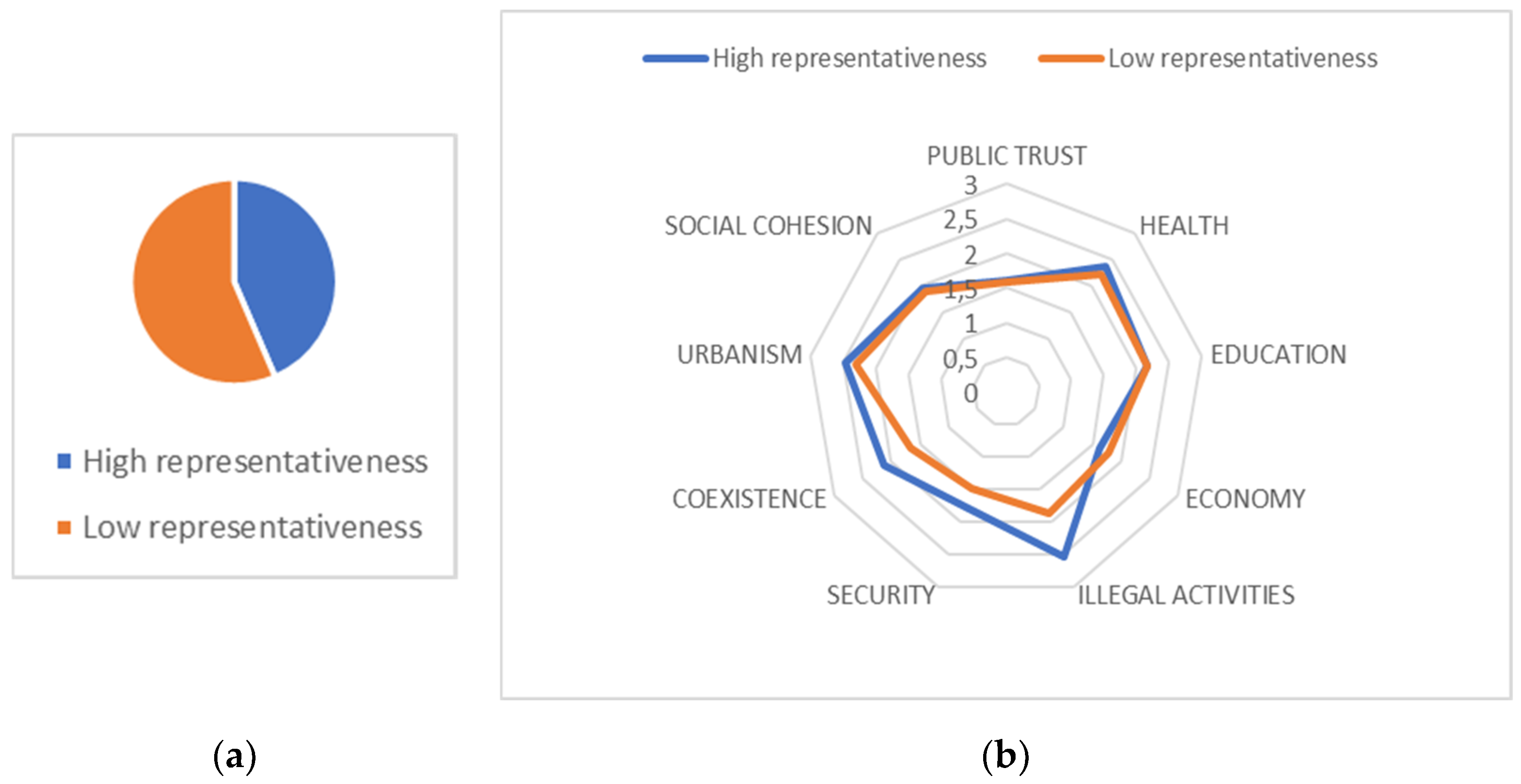
| Dimension | Definition | Topics |
|---|---|---|
| Public Trust | Confidence in public powers on the actors of the neighborhood | V0329, V0330, V0331, V0332 |
| Health | Physical and mental health of inhabitants and infrastructures | V0319, V0320, V0321 |
| Education | Educational level of inhabitants and infrastructures | V0301, V0302, V0303, V0304 |
| Economy | Wealth, employment, and financial capabilities of inhabitants | V0305, V0306, V0307, V0308, V0309 |
| Illegal activities | Presence of illegal activities, such as drugs and prostitution | V0310, V0311 |
| Security | Perceived and experienced sense of security by neighbors and visitors | V0312, V0313, V0317, V0318 |
| Coexistence | Mutual and beneficiary exchanges between neighbors | V0316, V0322, V0333 |
| Urbanism | Quality of the infrastructures and social exchanges they facilitate | V0323, V0324, V0325, V0326, V0327, V0328 |
| Social Cohesion | Mutual trust and confidence, level of social capital in the neighborhood | V0334, V0335, V0336 |
| Diversity | Presence of people from different ethnics, cultures, or origins | V0314, V0315 |
© 2020 by the authors. Licensee MDPI, Basel, Switzerland. This article is an open access article distributed under the terms and conditions of the Creative Commons Attribution (CC BY) license (http://creativecommons.org/licenses/by/4.0/).
Share and Cite
Sianes, A.; Vela-Jiménez, R. Can Differing Opinions Hinder Partnerships for the Localization of the Sustainable Development Goals? Evidence from Marginalized Urban Areas in Andalusia. Sustainability 2020, 12, 5797. https://doi.org/10.3390/su12145797
Sianes A, Vela-Jiménez R. Can Differing Opinions Hinder Partnerships for the Localization of the Sustainable Development Goals? Evidence from Marginalized Urban Areas in Andalusia. Sustainability. 2020; 12(14):5797. https://doi.org/10.3390/su12145797
Chicago/Turabian StyleSianes, Antonio, and Rocío Vela-Jiménez. 2020. "Can Differing Opinions Hinder Partnerships for the Localization of the Sustainable Development Goals? Evidence from Marginalized Urban Areas in Andalusia" Sustainability 12, no. 14: 5797. https://doi.org/10.3390/su12145797
APA StyleSianes, A., & Vela-Jiménez, R. (2020). Can Differing Opinions Hinder Partnerships for the Localization of the Sustainable Development Goals? Evidence from Marginalized Urban Areas in Andalusia. Sustainability, 12(14), 5797. https://doi.org/10.3390/su12145797






